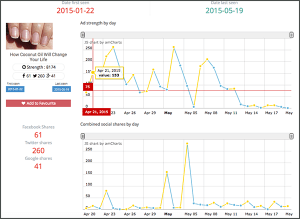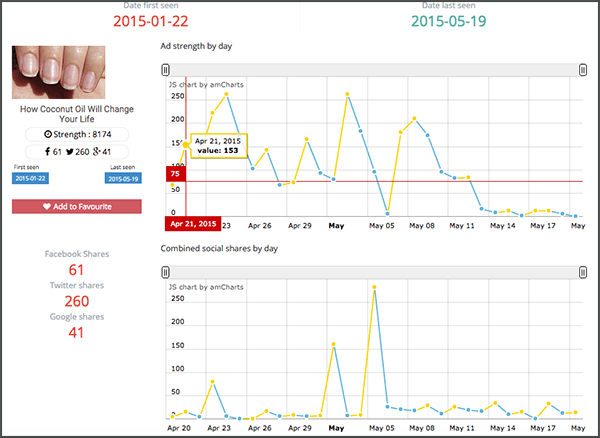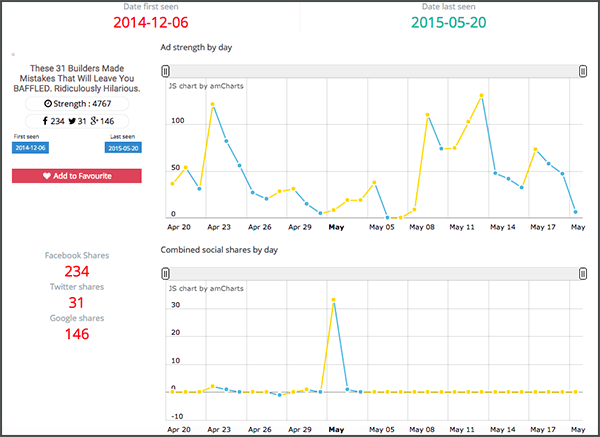
Compelling headlines have been evolving for thousands of years through spoken and printed media, right up to their modern day incarnations. I’m even willing to bet that the structure and hooks of these headlines hasn’t changed much over time.
Today, there is so much theoretical psychology mumbojumbo floating about regarding the art of persuasion. Often there is no real way to know whether it is true or not. When it comes to headlines however, it is possible to scientifically test which structures result in the clicks and conversions we desire and work our theories back from there.
In this article I’ve found 5 top performing ads using Native Ad Buzz, which have been active for several months. I have analysed their headlines in an attempt to understand the psychological principles that drive them and discover their powerful underlying structures.
If you want to get a head start before reading this article you can sign up to NativeAdBuzz spy tool
Yes I want to create world class native ad campaigns
What’s in a headline
Headlines serve many purposes, they can, among other things:
- act as a qualifier, attracting the right type of audience
- prime and prepare viewers consciously and unconsciously for what is about to come
- pre-sell and presuppose before the main offer
- interest viewers and excite curiosity
Some headline structures will be more suited to particular audiences and business models than others. For example, a mysterious headline which gives no clue as to the content may drive clicks but result in low engagement, where as a targeted headline detailing the specific content may result in fewer clicks, but higher quality engagement.
The Top 5 Headlines they don’t want you to use
The analyses that follow are suggestions based on common understandings of the English language and modern psychological principles. It is not necessary to understand the mechanisms of how something works for it to work, but it can help to have a story if you wish to recreate the same principles elsewhere.
1. How Coconut Oil Will Change Your Life

Structure: How [X] will change your [Y]
- The use of “Your Life” makes this personal. What’s more relevant than your own life.
- As many people are looking for quick simple answers, the use of a readily available popular food item makes this interesting.
- The headline indicates that “Change will happen” it’s not even up for discussion, it is definite statement of fact. The only question is ‘how this will happen’?
- The statement contextually presupposes that the change will have magnitude, and be for the better.
2. #1 WORST Exercise That Ages You Faster

Structure: #1 worst [something normally considered good] that [undesirable result] you [adjective]
- #1 has a very definite impact. It makes it easy to imagine, even though you don’t know what the specific thing is you can imagine something occupying the number 1 spot. The simplicity of this visualisation makes it simple to understand and psychologically easy to accept.
- Having WORST in capitals really hammers the first point home, just in case you didn’t get it. You can’t have a number 2 worst exercise.
- An exercise being bad for you seems to involve a contradiction of concepts: “Isn’t exercise supposed to be good for you? Gosh i hope i haven’t been harming myself by mistake!”
- This headline structure relies on loss bias, which is a particularly strong motivator, especially if it involves loss resulting from an avoidable action.
- Ageing faster is a hugely undesirable result, which has created a multibillion dollar evergreen industry. Typically people are more motivated to avoid pain then seek out pleasure, and the more painful the more likelihood of action.
3. These 31 Builders Made Mistakes That Will Leave You BAFFLED. Ridiculously Hilarious.

Structure: These [#] [group] made mistakes that will leave you [desirable feeling]. [desirable description of article]
- Humans have been evolutionarily programmed to seek out non-typical events and potential undesirable outcomes. You just have to read any newspaper to realise this. People are compelled to look out for mistakes.
- The labeling of a definite number of items, i.e 31 make the offering easy to understand and visualise, which results in cognitive ease and thus better engagement.
- It mentions “builders” specifically which makes the headline about people that commit errors rather than the errors themselves. People are the most interesting thing to people, they are central to all stories.
- Capitalising the word “BAFFLED” draws the mind away from the actual core message to the feeling associated with the adjective, and whatever associations the reader may have with this word. I imagine that the author is banking on the majority of people associating with a mixed state of mild entertainment and confusion. Either way the adjective will likely conjure up readily available images for the reader. Being able to easily visualise enhances the feeling of cognitive ease.
- The use of the description “ridiculously hilarious” lets the reader know the angle the content is going for.
4. Unique Method Regrows Lost Hair (Do This Daily)

Structure: Unique method to [desirable action] (do this daily)
- “unique” lets the reader know there is only one solution and you can not find it anywhere else except for here.
- The headline promises a solution to a common painful problem.
- The fact that it can be done daily presupposes the method is readily available and easy to accomplish.
- It is an evergreen market as men are going bald every day and many would give anything to stop it.
5. Online Casinos – The Truth Finally Exposed!

Structure: [Group, person, industry or product] – The truth finally [exposed, revealed, uncovered or discovered]
- The use of a specific group qualifies an audience who has an interest in this group, especially those that might have a vested interest in some untoward secret that has been kept.
- The truth being exposed presupposes there has been deliberately hidden truth. This is often done for nefarious reasons and results in harm. The desire to avoid pain, or gain pleasure by discovering something new is a strong motivating force.
- The use of the word truth presupposes that the article is all you need as truth is absolute, and the use of “finally” indicates that after this expose there is nothing else to know.
- “exposed” is a strong emotional word, often associated with being laid bare to the elements or harm. This link with pain, damage or undesirable results brings a strong emotional tone increasing intensity and interest.
Conclusions
Have another read through and think how you could adopt these 5 headline structures for your own use.
When you are testing headlines for your own material have fun imagining how they may affect and motivate your audience. To do this it is often easiest to represent your audience as a specific individual or avatar.
Theories and analysis provide a great place to start from and make predictions. However, no matter how great or compelling your theory, testing is always king.
Want more great headline structures? Get 76 scientifically tested headlines when you download the 60 Second Native Ad Checklist for free!
